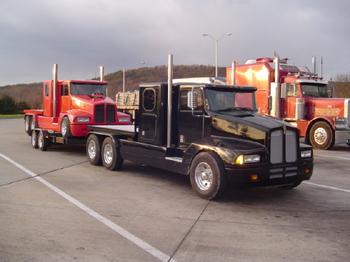Big rig towing services play a crucial role in maintaining road safety and efficiency. Given the size and weight of big rigs, which can exceed 80,000 pounds, the complexity of towing such massive vehicles necessitates rigorous safety protocols. These protocols ensure that the towing process is executed efficiently, minimizing risks to personnel and the public.
In this article, we will delve into the various safety protocols that are essential for big rig towing, outlining best practices and providing insights into the latest industry trends.
2. Understanding Big Rig Towing
Definition and Scope
Big rig towing refers to the process of recovering or transporting large commercial trucks, trailers, and other heavy-duty vehicles. These services are essential in cases of breakdowns, accidents, or when vehicles need to be relocated for maintenance or legal reasons.
Types of Big Rig Towing Services
- Emergency Towing: Provides immediate assistance in case of vehicle breakdowns or accidents, often requiring rapid deployment and advanced equipment.
- Long-Distance Towing: Involves transporting vehicles over extended distances, which can include interstate or cross-country travel.
- Recovery Services: Focuses on retrieving vehicles from difficult or hazardous situations, such as ditches or overturned positions.
3. Safety Protocols in Big Rig Towing
Importance of Adhering to Safety Protocols
Safety protocols are vital to prevent accidents and ensure the effective operation of towing services. These protocols protect the lives of drivers, towing personnel, and other road users. Adhering to these guidelines minimizes potential damage and operational disruptions.
Key Safety Guidelines
- Pre-Towing Inspection: Conduct thorough checks of the vehicle and equipment before initiating the towing process.
- Securing the Vehicle: Ensure the vehicle is properly secured to prevent shifting during transit.
- Proper Equipment Usage: Use the correct equipment and tools for the job to maintain safety and effectiveness.
- Communication Protocols: Establish clear communication channels between towing personnel and other involved parties.
4. Pre-Towing Inspection
Vehicle Inspection Checklist
Before towing, it is crucial to inspect the vehicle to ensure it is safe to tow. This includes checking:
- Tires and Wheels: Ensure that the tires are in good condition and properly inflated.
- Fluid Levels: Check for adequate levels of oil, coolant, and other essential fluids.
- Electrical Systems: Verify that the vehicle’s electrical systems are functioning properly, including lights and signals.
Assessing Road Conditions
Evaluate the road conditions where the towing will occur. This includes checking for obstacles, slope gradients, and weather conditions that could affect the towing process.
Evaluating Tow Truck Equipment
Ensure that the tow truck and its equipment are in optimal working condition. This includes inspecting the winch, hydraulic systems, and other essential components.
5. Securing the Vehicle
Techniques for Proper Securing
Proper securing of the vehicle is critical to prevent movement during transit. Techniques include:
- Use of Chains and Straps: Secure the vehicle using high-strength chains and straps to keep it firmly in place.
- Load Distribution: Distribute the weight evenly to maintain balance and prevent tipping.
- Weight Limits: Adhere to the maximum weight limits of the tow truck to avoid overloading.
Types of Straps and Chains
Various types of straps and chains are used in towing, including:
- Ratchet Straps: Adjustable and strong, ideal for securing vehicles of various sizes.
- Heavy-Duty Chains: Used for more substantial vehicles or loads.
Common Mistakes to Avoid
Common mistakes include using insufficiently strong straps or chains, improper load distribution, and neglecting to double-check securements before transport.
6. Equipment and Tools
Essential Towing Equipment
The right equipment is crucial for safe and effective towing. Essential tools include:
- Tow Trucks: Heavy-duty trucks equipped with towing capabilities.
- Winches: Devices used to pull and secure vehicles.
- Hydraulic Tools: Used for lifting and stabilizing vehicles during the towing process.
Maintenance of Towing Equipment
Regular maintenance of towing equipment is necessary to ensure reliability and safety. This includes checking hydraulic fluids, inspecting winch cables, and servicing tow truck components.
Upgrading Towing Tools
Staying updated with the latest towing technologies can improve efficiency and safety. Consider upgrading to newer equipment with enhanced features and capabilities.
7. Communication Protocols
Importance of Clear Communication
Effective communication is essential for coordinating towing operations and ensuring safety. Clear communication helps prevent misunderstandings and accidents.
Tools for Effective Communication
- Radios: Provide instant communication between towing personnel.
- Signal Lights: Used to indicate intentions and actions to other road users.
Protocols for Handling Emergencies
Establish protocols for emergency situations, including using emergency signals and coordinating with emergency services.
8. Handling Emergencies
Common Emergency Scenarios
Emergency scenarios in towing can include:
- Vehicle Breakdowns: Situations where a vehicle suddenly fails and needs immediate towing.
- Accidents: Incidents involving collisions that require quick recovery and towing.
Safety Measures During Emergencies
During emergencies, prioritize safety by:
- Assessing the Situation: Evaluate the scene to determine the safest approach.
- Protecting the Scene: Use warning lights and signs to alert other drivers.
Contacting Emergency Services
When needed, contact emergency services to assist with accidents or hazardous situations. Ensure that all necessary information is communicated clearly and promptly.
9. Legal and Regulatory Requirements
Compliance with Local Laws
Adhere to local regulations governing towing operations. This includes following rules related to equipment, licensing, and operational procedures.
Permits and Licenses Required
Certain jurisdictions may require specific permits and licenses for towing operations. Ensure that all necessary documentation is obtained and kept up-to-date.
Insurance Requirements
Maintain adequate insurance coverage for towing services to protect against potential liabilities and damages.
10. Training and Certification
Importance of Professional Training
Professional training is essential for ensuring that tow truck operators are skilled and knowledgeable in safe towing practices.
Certification Programs for Tow Truck Operators
Certification programs provide comprehensive training and assessment for tow truck operators. These programs often cover safety procedures, equipment usage, and emergency handling.
Ongoing Training and Skills Development
Continuously update skills and knowledge through ongoing training and professional development opportunities.
11. Case Studies and Real-Life Incidents
Notable Towing Incidents
Explore case studies of significant towing incidents to understand the challenges and solutions involved. Analyze what went right or wrong to learn valuable lessons.
Lessons Learned from Case Studies
Reviewing case studies helps identify best practices and areas
11. Case Studies and Real-Life Incidents (Continued)
Lessons Learned from Case Studies
Reviewing case studies from notable towing incidents provides valuable insights into effective practices and potential pitfalls. For example:
-
Case Study 1: Highway Collision Recovery
An incident involving a major highway collision required immediate towing and recovery of multiple vehicles. Key lessons included the importance of efficient communication between towing teams and emergency services and the necessity of using the correct equipment to handle different vehicle types. -
Case Study 2: Overturned Truck Recovery
In a scenario where a truck overturned on a rural road, the recovery process highlighted the need for thorough pre-towing inspections and the use of specialized lifting equipment. The incident also underscored the importance of ensuring road safety through proper signage and barriers.
By analyzing such incidents, towing professionals can refine their protocols, improve safety measures, and enhance overall service quality.
12. Future Trends in Big Rig Towing
Technological Advancements
The towing industry is experiencing rapid technological advancements that improve safety and efficiency. Key trends include:
- Automated Tow Trucks: Emerging technologies are introducing automated systems that can assist with towing operations, reducing the reliance on manual labor and enhancing precision.
- GPS Tracking and Monitoring: Advanced GPS systems allow for real-time tracking of tow trucks and vehicles, improving coordination and response times.
Emerging Safety Protocols
New safety protocols are being developed to address evolving challenges in towing. These include:
- Enhanced Load Stabilization Techniques: Innovations in load stabilization are designed to secure vehicles more effectively during transport.
- Advanced Communication Systems: Modern communication tools facilitate better coordination among towing teams and other involved parties.
Predictions for the Industry
The future of big rig towing is likely to see continued integration of technology, with more emphasis on automation, real-time data analysis, and improved safety measures. These advancements are expected to enhance operational efficiency and safety.
13. Expert Opinions
Interviews with Towing Experts
Consulting industry experts provides valuable insights into best practices and future trends in towing. Experts may include experienced tow truck operators, safety trainers, and equipment manufacturers.
Advice from Industry Professionals
Professional advice often emphasizes the importance of continuous learning and adaptation. For instance, experts may recommend investing in advanced training programs and staying updated with industry regulations and technological developments.
14. Conclusion
Recap of Key Safety Protocols
Effective big rig towing requires adherence to stringent safety protocols to protect all parties involved. Key protocols include conducting thorough pre-towing inspections, securing the vehicle properly, using appropriate equipment, and maintaining clear communication.
Final Thoughts on Best Practices
By implementing and regularly updating safety practices, towing professionals can ensure high standards of service and safety. The ongoing evolution of technology and industry standards will continue to shape the future of big rig towing, presenting both challenges and opportunities for improvement.
15. FAQ
What are the basic safety protocols in big rig towing?
Basic safety protocols include performing pre-towing inspections, ensuring proper vehicle securing, using appropriate equipment, and maintaining effective communication with all parties involved.
How do you prepare a vehicle for towing?
Prepare a vehicle for towing by inspecting tires, fluid levels, and electrical systems. Ensure the vehicle is properly secured using chains and straps, and assess the road and towing equipment conditions.
What equipment is essential for big rig towing?
Essential equipment includes tow trucks, winches, hydraulic tools, and safety gear. Regular maintenance and potential upgrades to these tools are also important.
How can communication be improved during towing operations?
Communication can be improved by using radios, signal lights, and establishing clear protocols for handling emergencies. Effective communication ensures smooth coordination and reduces the risk of misunderstandings.
What are the legal requirements for towing services?
Legal requirements may include obtaining specific permits and licenses, complying with local regulations, and maintaining adequate insurance coverage. Ensure that all necessary documentation is current and in compliance with applicable laws.



